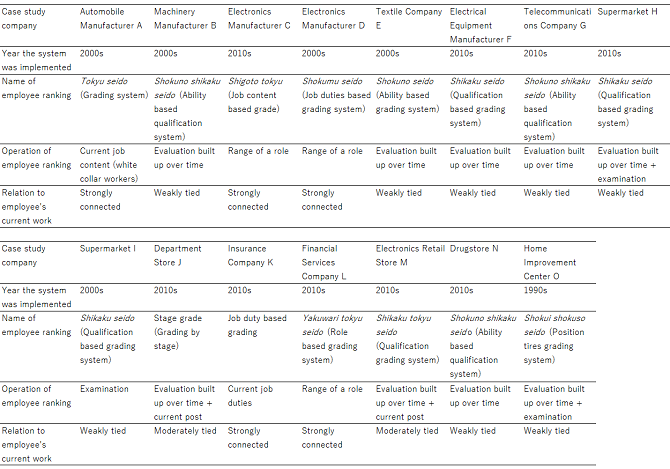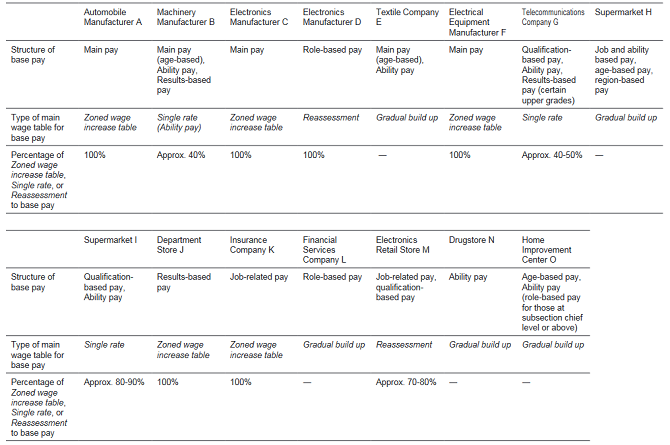JILPT Research Report No.212
Research on Companies’ Wage Determination
February 25, 2022
Summary
Research Objective
This research sheds light on the current development of personnel and wage systems in Japanese companies and the actual situations of their wage increases provided under these systems, aiming for achieving a better mechanism of wage determination.
Research Method
Literature review and interview survey
Key Findings
1. Seven of the 15 companies surveyed adopt an approach by which the employee grade in which an employee is ranked is to some extent related to the employee’s current job content (see Table 1). Data focusing specifically on non-managerial employees show that a certain number of companies place emphasis on the current job content when determining employees’ grades. Even in the period from the mid-2000s to the 2010s, when the negative effects of the performance-related pay scheme were identified, the trend toward strengthening such a correlation between an employee’s grade ranking and the current job content was maintained. However, only a small number of companies used the labor market task value as a ranking criterion. In other words, rather than ranking based on the external labor market task value, which is a benchmark common to all companies, companies tend to use their individual perspective as the entity operating the business to devise a hierarchical structure according to employees’ positions and specific job duties, and rank employees on that basis.
2. Looking at the main wage table adopted for basic wages, many companies have introduced wage table that take a different approach from the previous conventional Tsumiage-gata (gradual build up type) wage table. An increasing number of companies are introducing wage tables that define an appropriate wage level at each qualification grade, such as Single rate wage table or Zoned wage increase table (see Table 2). The nature of wage table has therefore changed such that when an employee’s qualification grade ranking remains the same, the amount of wages received also remains the same or settles in the range of the wage level defined in the relevant qualification grade, rather than adopting a system by which wages fluctuate drastically according to performance. That is, wages appear to be becoming increasingly fixed as opposed to variable. At the same time, the appropriate wage levels are largely defined by each enterprise independently, in consideration of that enterprise’s former wage levels and other such aspects, rather than being devised on the basis of market rates formed across the external labor market or otherwise outside the enterprise. Thus, Japan’s distinctive tendency to maintain a certain distance between the wages determined within companies and the external labor market rates is still being preserved.
Table 1. Names and distinctive features of employee ranking systems at case study companies

- Source: Compiled by the author using data from interview surveys.
Note: For the relation to the employee’s current job, “strong,” “medium,” and “weak” are based on the relative comparison between the surveyed companies.
3. Looking at the companies’ systems for raising basic wages (across-the-board wage raises, called base up in Japan), not all of the surveyed companies had implemented base up. Some companies chose not to implement base up, on the basis of their enterprise’s particular circumstances or labor and management’s perception of issues. Among those companies that implemented base up, a tendency was seen toward allocating base up individually for each employee. This may be attributable to the base up portions of wage increases as means of solving issues faced by workplaces and for securing wage increase amounts that correspond to employees’ job performance, rather than means of improving the standard of living of employees as a whole. This seems to indicate changes arising in the objectives of base up itself.
4. Regarding the negotiation of bonuses (lump sum payments), there are two principal ways of determining bonuses: determining bonuses based on business performance and negotiations to determine the number of months for which bonuses are calculated. The number of companies using the performance-related approach appears to be on the rise, as some of the companies surveyed have switched from the number-of-months’ negotiation approach to the performance-related approach since 2014. Considering those companies that adopt neither type of those approaches exist, the ways of negotiating bonuses also appear to be more diversified. Nevertheless, bonuses have retained their typical stability, because, regardless of the kind of approach adopted, minimum levels are in place.
Table 2. Distinctive features of wage tables for regular employees’ basic wages (15 case study companies)

- Source: Compiled by the author using data from interview surveys.
5. In managing the wages of part-time workers in the context of rising regional wage market rates and the recent increase in regional minimum wages, some of the companies surveyed are (were) facing challenges. One of these challenges is to address the problem that the portion of the wage increase reflecting performance evaluation is cancelled out by the increase in market rates. In response to such challenges, labor and management are responding through such measures as (i) clearly separating wage components that are affected by fluctuation in regional rates and wage components reflecting employees’ performance, and (ii) adjusting the payment timing of the portion reflecting ability. Labor and management are fulfilling a certain role in ensuring an increase in the level of wages across the labor market as a whole while avoiding a decline in the efficiency of companies’ internal personnel management.
Policy Implications
- Wages can be said to possess two main functions: serving as an incentive and as a means of livelihood. It is necessary to develop a system that can balance these functions without diminishing either of them. Since the wages of regular employees are determined according to the rules of the organization and the labor market has no influence on them, it will certainly be necessary to establish an environment in which labor and management within the organization can engage in thorough discussion.
- Labor and management have a significant role to play in ensuring that wage policies produce more positive impacts. It is the labor and management within companies that have raised the wage level for part-time workers in the form of increases in regional minimum wages, while maintaining the capacity of wages to serve as an incentive. Therefore, it can be suggested that in order to develop desirable wage-related policies without diminishing the two main functions of wages, it is necessary to develop frameworks in which the labor and management within companies can pursue more active debate in the future.
Policy Contribution
This research will be used to support¬ the effective and efficient further development of labor and employment policies (including practical implementation, such as at Hello Work, public employment security offices.
Contents
- JILPT Research Report No.212, full text (PDF:3.7MB) [in Japanese]
Category
Working conditions/work environment, Employment/unemployment, Industrial relations
Research Period
April 2017 - March 2021
Authors
- NISHIMURA Itaru
- Vice Senior Researcher, The Japan Institute for Labour Policy and Training
- MAEURA Hodaka
- Vice Senior Researcher, The Japan Institute for Labour Policy and Training
- YAMABE Masashi
- Assistant Fellow, The Japan Institute for Labour Policy and Training
For Citation
JILPT. 2022. Kigyo no chingin kettei ni kansuru kenkyu [Research on Companies’ Wage Determination], JILPT Research Report no.212. Tokyo: The Japan Institute for Labour Policy and Training.
Related Research
-
Discussion Paper 16-03 “Some Observations and future research issues on the Evolution of Personnel Management and Wage Systems” (2016)
-
JILPT Research Series No.28, Survey on the Developments of Wage System Reforms at Major Corporations: Wage System Reform of Major Electrical Machinery Manufacturers since the 1990s II (2007)
-
JILPT Research Series No.23, Survey on the Developments of Wage System Reforms at Major Corporations: Wage System Reform of Major Electrical Machinery Manufacturers since the 1990s I (2006)
JILPT Research Report at a Glance
| To view PDF files, you will need Adobe Acrobat Reader Software installed on your computer.The Adobe Acrobat Reader can be downloaded from this banner. |

